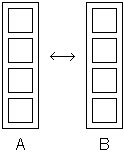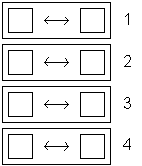Of late I've heard much talk about RAID 1+0 being better than RAID 0+1, but never got a good answer why. Leah and I started talking about this over dinner one night and did a little math (literally on the back of a napkin) to calculate how much better. Here's what we figured out.

RAID 0+1 configuration where multiple disks are striped together into sets (sets A & B in the diagram, each set being as large as the resulting final volume), and then two or more sets are mirrored together.

RAID 1+0 configuration where two or more drives are mirrored together (mirrors 1-4 in the diagram), and then the mirrors (as many as are needed to result in the desired amount of space) are striped together.
In either case (0+1 or 1+0), the loss of a single drive does not result in failure of the RAID system. The difference comes in the chance that the loss of a second drive from the system will result in the failure of the whole system. In RAID 0+1, you have to lose one drive from each disk set to result in the failure of the whole system. In my diagram that would be one drive from set A and one drive from set B. In RAID 1+0, you have to lose all drives in a mirror. This would be both drives in any numbered pair in the diagram.
Mathematically, the difference is that the chance of system failure with two drive failures in a RAID 0+1 system with two sets of drives is (n/2)/(n - 1) where n is the total number of drives in the system. The chance of system failure in a RAID 1+0 system with two drives per mirror is 1/(n - 1). So, using the 8 drive systems shown in the diagrams, the chance that losing a second drive would bring down the RAID system is 4/7 with a RAID 0+1 system and 1/7 with a RAID 1+0 system.
The math gets more complicated when you have more than two elements to a mirror. Since that's a rare configuration, I haven't bothered to figure out the equations. If someone else would like to, I'll be glad to post them here.
Another difference between the two RAID configurations is performance when the system is in a degraded state, i.e. after it has lost one or more drives but has not lost the right combination of drives to completely fail. In a RAID 0+1 configuration, the loss of any drive in a set causes the failure of that entire set and the set is removed from the RAID system. Generally (in the two set case) this means you are left with a RAID 0 system made up of the remaining set of disks. This probably slightly improves write performance and slightly degrades read performance (but that's just a WAG, I haven't done any testing). In a RAID 1+0 system, you would see the same effect on each mirror that loses a drive, but not the whole system. In other words, a RAID 1+0 configuration will tend to show similar, but less dramatic, changes in performance when in a degraded mode than RAID 0+1. However, the changes will likely be slight in any case.
One more difference that was recently pointed out to me is the speed at which the RAID system recovers once the failed disk is replaced. RAID 1+0 only has to re-mirror one drive, whereas RAID 0+1 has to re-mirror the entire failed set. So RAID 1+0 will recover significantly faster.
There used to be a list here of products that did or didn't support RAID 1+0. The list got too long for me to maintain. Ask the vendor or something. Usually you can find this in the documentation for the product, but it is frequently in the fine print.